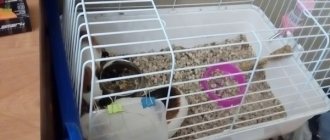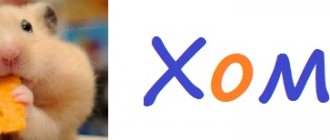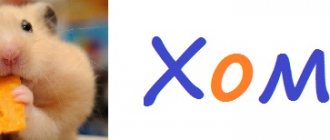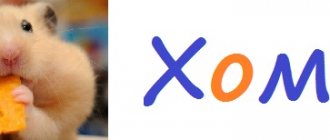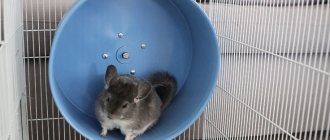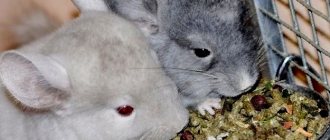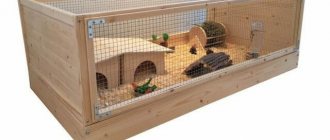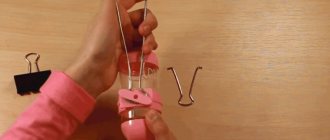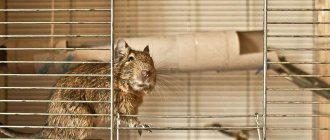A guinea pig rack is a great alternative to a cage. Buying a spacious home for a pet is often problematic. But placing such a large pet, compared to other rodents, in a small house is also not an option. For an animal to be healthy and cheerful, it needs to move a lot, and this requires a sufficient amount of free space. The problem is solved by creating a shelving house for the animal with your own hands. This will provide the pig with space for entertainment and freedom of movement, but will not require large material costs.
The advantages of such housing for guinea pigs
Furry rodent shelving has many different benefits. The structure, like ordinary furniture, is easily matched to the interior. If you focus on the surrounding environment when creating a structure and developing its design, then the pig rack will become a real decoration of the room. Inside such a home there is a place to place everything that a pig needs to be happy:
- privacy shelters;
- feeders and drinkers;
- stairs;
- tunnels, etc.
There is no need to make playgrounds separate from the main housing - all attractions and sports equipment can be placed on the same or different levels of the rack. The pig will be able to have fun any time she wants. The presence of several floors allows you to create a multi-room house for the animal with areas for a specific purpose - a bedroom, a dining room, a playroom, etc. Transparent front sides provide a good overview, you can keep an eye on your pet and control where exactly it is and what it is doing.
The dimensions of the rack and, again, its multi-level nature make it possible to accommodate more than one pig in such a house. In this kind of “cottage”, rodents will not fight for territory - there is enough space for everyone. And, if something happens, the neighbors will be able to go to different rooms.
Compared to a regular cage, the shelving design makes much less noise when the pig is getting busy. In addition, through the walls and ceilings of such a structure, debris (particles of bedding, filler, etc.) practically does not get out, unlike the bars of the cage, through which all small elements fly out.
Minimum requirements for conditions of detention
Before getting a guinea pig, it is important to create the necessary conditions for it. It is worth taking care that the animal does not become exhausted from lack of space.
The temperature regime is also extremely important and should be between 17-20º C.
Do not forget about the need to regularly ventilate the room in which the cage with the rodent will be located. However, drafts are prohibited for the animal
It is important to take care of good lighting, given that direct sunlight can harm your pet.
When the location of the enclosure has been determined, it is time to figure out what apartments the animal needs. It is not easy to name specific parameters, because they are individual for each guinea pig.
But it is important to consider the minimum requirements for a comfortable stay for a pet:
- 40x80 cm - the smallest dimensions of the cage, with a height of 50 cm;
- presence of a pallet. This condition will make the cleaning process easier. But you should not choose a container that is too deep, as the animal will lose the opportunity to look out;
- It is forbidden to neglect safety. Any chips, defects and cracks can cause harm to the guinea pig;
- convenient feeder. Practice will help you choose the right kitchen equipment for your animal. Some people prefer floor-mounted bowls, while others prefer pull-out or outdoor designs. The main thing is that it is convenient for the pet to eat, and he cannot turn the feeder over, spilling its contents;
- presence of hay. Hay is an essential nutritional supplement in a guinea pig's diet as it is the main source of protein. If there is such a piece of furniture for the pet, we will not scatter food throughout the cage;
- drinking bowl A guinea pig can use either a special device or a simple bowl. However, it is better to give preference to an automatic drinking bowl. This way, debris and pollution will not get into the water, and the litter will remain dry;
- filler. For rodents, compressed wood pellets are best. This filler absorbs moisture, eliminates odor and is used sparingly;
- house. Not a single living creature would refuse to rest in peace and quiet. Having a house in a cage will help the animal hide from the surrounding noise and get some sleep.
Tips for selection and installation
When selecting and installing a rack structure, certain rules and recommendations should be followed. The design of the pig's home should be combined with the other furnishings of the room and the interior as a whole.
The rack is installed at a distance of at least 5 cm from walls and furniture. It is prohibited to place the structure near heating devices, or under direct sunlight. The lack of light is also not beneficial for pigs, so it needs to be supplemented with artificial lighting (a garland of lanterns, etc.).
The minimum permissible height of the tiers is 30–35 cm, the recommended one is 40–60 cm. As for the area of the home, the larger it is, the better. For a comfortable stay of one animal, a minimum of 50–70 cm² is required, for two pets - at least 90 cm².
If possible, it is worth purchasing for a friend's pet. In nature, guinea pigs do not live alone, so such an existence is unnatural for them. Even if the owner pays the proper amount of attention, the pet still needs to communicate with its relatives.
A rodent living alone eats more and moves less than its relatives living side by side. Therefore, in order for your pet not to get bored, to be cheerful and cheerful, it is worth placing a neighbor with him. If there are a lot of animals, you should prefer a high multi-tiered structure. The design up to the ceiling is easier to fix and saves space in the room.
It is better to allocate the upper tier for the bedroom. It is also recommended to place mini-houses on top for privacy. A feeding trough and drinking bowl must be installed on one of the floors (several are allowed). A pet’s home should not consist only of a sleeping and dining room - it is also necessary to equip a play area.
Frame material
The first and most important criterion when choosing a rack is the frame material.
Nowadays, in the vast majority of cases, shelving is made from solid wood or laminated chipboard. Sometimes there are products made from plywood.
If we talk about solid wood, it is most often pine, since it is the most affordable natural wood. If you want something exotic, you can, of course, order a house made of oak for your favorite pig, but it will cost many tens of thousands.
It goes without saying that a house made from solid wood will be more environmentally friendly, more durable and of higher quality than one made from chipboard. It’s not without reason that wooden furniture has always been valued much more than modern “pillars”, whose edges fly off after a couple of years, and under the influence of liquids they begin to swell and deform (do not forget that guinea pigs produce quite a lot of liquid during their life ).
So, let's look at the advantages and disadvantages of racks made of chipboard .
The most important advantage of such structures is their relatively low cost.
The main disadvantages of laminated chipboard are:
Not environmentally friendly. In the manufacture of laminated chipboards, urea-formaldehyde and phenol-formaldehyde resins are used. These substances prevent the processes of wood decay, however, they do not have the most favorable effect on human health. And animals.
Fragility. Laminated chipboard absorbs moisture well and is deformed.
The photo below shows an example of a rack made of chipboard.
Now let's look at the advantages and disadvantages of solid wood shelving
How to make a rack for guinea pigs with your own hands
As already noted, in order to provide your pet with such luxurious living conditions, large material investments are not required. You can make a comfortable rack for guinea pigs with your own hands. Wood should be preferred as a material:
- boards;
- plywood;
- OSB boards;
- Chipboard.
The last option is the best, especially if the chipboard has a laminated coating. This material has the greatest moisture resistance among others. Wooden materials allow you to construct a shelving unit with an interesting unique design and shaped decorative elements.
You can only use smooth boards - protruding knots will injure your pet. The wooden structure should be coated with varnish or paint so that the pig does not chew the structure.
Preparatory work
Before starting work, you need to “arm yourself” with the necessary materials and tools:
- Chipboard or boards;
- plywood;
- glazing beads or slats;
- jigsaw or wood hacksaw;
- pencil;
- tape measure;
- electric drill;
- self-tapping screws;
- plexiglass (6 mm thick);
- glass cutter.
To create shelves less than 1 m long, chipboard or boards 1.5 cm thick are suitable. If the shelves are longer than 1 m, you need boards or chipboard 2-2.5 cm thick. In addition, you will need to strengthen them with additional slats. The recommended shelf width is 25–50 cm.
Before purchasing the necessary materials, you need to think through the location of the rooms and compartments, determine their sizes and draw a detailed drawing of the future shelving. The number of shelves and their length are determined by their location and the number of intended occupants. Two tiers 1 m long and half a meter wide are enough for two animals.
Manufacturing of the structure
The step-by-step procedure is as follows:
- Cutting out the main structural elements from chipboard or boards - bottom, shelves, side walls.
- Cutting out the back wall from plywood.
- Cutting holes in the shelves so that the pig can move from floor to floor. The width of the openings should correspond to the dimensions of the animal.
- Cutting out the front sides from plexiglass.
- Creation of plywood stairs connecting tiers.
- Fastening the walls (side and back) to the bottom. To do this, holes are drilled in them using a drill, after which the parts are connected using self-tapping screws.
- Installing shelves (also using a drill and self-tapping screws).
- Equipment for the interior of the house - securing stairs, installing feeders, drinking bowls and other elements that require securing. Then the bed and other furnishings provided are placed inside.
- Fastening glass edges using glazing beads or slats.
Now all that remains is to make the bedding, fill the bowls and let the furry new settler inside the house.
Moisture protection
How to protect the rack frame from moisture is one of the most important issues when choosing a rack. If this aspect is neglected, then a brand new rack will become unusable after just a few months due to deformation of the frame - once and an unpleasant smell - twice. After all, even when using filler or sawdust, the liquid still gets onto the shelving frame and is absorbed. Some breeders use waterproof diapers to solve this problem. Well? Also an option! If you are ready to spend money on diapers, then a rack without moisture protection is quite suitable.
But there are better ways!
In those racks that are on the market today, to solve the “wet” problem, as a rule, two options are used - plastic pallets and interior decoration with polycarbonate, plexiglass (also known as organic glass, polymethyl methacrylate, acrylic glass) or similar moisture-proof materials.
Of course, neither one nor the other option can be called environmentally friendly, but all other things being equal, pallets still look more advantageous. Why? Firstly, the pallet is a one-piece structure, without seams or cracks, which protects the frame of the rack from leaks and ensures a longer service life. And secondly, having a pallet makes life a lot easier! Cleaning the rack takes much less time! I took out the tray, poured the filler into a bag, washed it - and you're done! This is not tedious picking out filler or sawdust from all corners and hard-to-reach places with a scoop and brush!
The photo below shows a natural wood shelf with a pallet. By the way, you can buy one of these right now in our Guinea Pig Store.
Polycarbonate/Plexiglas
Finishing with polycarbonate or plexiglass is a more economical way to protect against moisture; such racks are usually cheaper than those with pallets.
The main disadvantage of polycarbonate and plexiglass is the presence of seams at the joints of the floor and walls. These seams, of course, are sealed with moisture-resistant silicone sealant, but, as our practice shows, over time the sealant comes off and moisture still begins to get into the cracks, causing damage to the frame.
You may have better luck, but in our opinion, the pallet is still more convenient and reliable in this regard.
The next photo shows a solid wood shelf with plexiglass trim.
It is not so important whether you choose a rack with a pallet or with polycarbonate. The main thing is that there is protection from moisture in principle! Because while collecting material for the article, I repeatedly came across proposals for the sale of shelving without protection in principle. Well, somehow unprofessional, or something.
Cage shelving made from finished furniture
An even simpler option is to make a shelving unit for your guinea pig from ready-made furniture. All kinds of cabinets are perfect for this:
- book;
- tableware;
- display racks, etc.
If you don’t have a free locker among your own furniture, you can buy a suitable one in a store or second-hand, according to an advertisement. You should prefer models with initially installed wooden shelves - glass ones will have to be replaced with wooden ones. On the shelves of book and china cabinets, sides are installed, preferably made of lattice.
Traditional plastic carrier
Perhaps the most common way to move small animals. Very well suited for long-distance travel, but in a car (and especially on a bicycle) a bulky plastic box is not very convenient.
Among the advantages, we note excellent breathability, ease of cleaning and maintenance, the ability to organize meals while traveling, hygiene, strength and durability.
The disadvantages are determined by the need to allocate space for storing this box and, of course, the outdated design. It is necessary to have such a device in stock, but it is not very suitable for short-term forays outside the city.
Cost – 1,146 – 2,137 rubles.
Housing for guinea pigs based on a metal rack
To build a multi-story “cottage” for your pet, a metal rack is suitable. The removable elements of this design can be easily swapped, adjusted in height, etc. If you need a larger house, it is enough to create a single structure from several racks.
One end of the house is covered with plywood or other material. A metal mesh is attached to the other end and back side. It is better to make doors from plexiglass. When building a home for an animal from a metal rack, the shelves are installed upside down to create a kind of pallets.
You can easily give your pet a luxurious home by making it yourself or simply giving an old closet a second life. A properly created shelving structure is not just a comfortable house for your pet. With a creative approach to the construction of this home, it will become a real decoration of the interior.
For what?
Unlike decorative rats, a guinea pig has short legs and cannot climb over all kinds of obstacles. Therefore, a hammock is an ideal place for it. It will become an excellent shelter and place of relaxation for the animal after outdoor games. First of all, the breeder needs to know that the animal’s legs and spine are quite weak. In this regard, a high-hanging hammock will only cause inconvenience to your pet.
The animal may make an unsuccessful jump and suffer a serious fracture. The “bed” for fluffy “piglets” should have excellent tension and be fixed between the two walls of the “dwelling”. The most convenient height is 6–8 cm from the floor level.
Naturally, a ready-made hammock can be purchased at any pet store. But for the sake of economy, you can do such a thing with your own hands. In addition, its creation does not require professional skills and knowledge, and the manufacturing process itself is quite interesting and creative.
Friend or Prisoner? Cage/enclosure equipment
Keeping guinea pigs in a small cage, loneliness and boredom mean torment and suffering for these animals.
Pigs are considered simple and undemanding animals to keep. Because of their cute appearance and helplessness, they are often bought as toys for children. However, for these sensitive and social animals, loneliness and captivity mean enormous suffering. Poor maintenance turns animals into sick, aggressive, apathetic creatures with behavioral disorders.
Despite domestication, the need for movement has not changed. Therefore, guinea pigs need a large area to satisfy their movement needs. It should be borne in mind that pigs are not for playing and petting people. The will and needs of these animals must be respected and respected, and their defenselessness must not be taken advantage of. Therefore, before you get a pig, ask yourself the question: do you have enough space in your apartment for a cage and enclosure?
Small cage, aquarium, dune habitat are not suitable
Millions of these animals are forced to suffer in cages 60 by 40, and often even smaller, and even in complete isolation. There is no law to protect pets. Out of ignorance or out of their own selfishness, many owners condemn their pigs to a miserable and martyr's existence locked up. Pet stores, books, outdated information on the Internet and many breeders are campaigning for keeping them in such cages, thereby promoting cruelty to animals. For both of them, pigs, cages, and food are just a commodity. No more.
A thoughtless purchase of a pig (or other animal) turns into a tragedy, primarily for the pig itself. As it is no longer needed, the cage along with the animal is put in the far corner, sometimes food of dubious quality is thrown in there. Or the owners are busy (working, studying), determining the time for the pig’s walks, following their own rhythm of life. Meanwhile, the pigs suffer in silence! They can't say if they don't like something. They suffer for years from boredom, loneliness and lack of mobility.
It should be understood that a small cage will never satisfy the needs of either a baby or an adult. Taking into account the social nature of pigs, solitary housing of these animals is unacceptable for ethical and animal welfare reasons. Under no circumstances should two animals be locked in an area whose dimensions are less than 100 by 60 cm. In addition, cell bars pose a serious danger to teeth and injure lips, because The pig starts gnawing on the rods to the point of stupor. Many owners remain perplexed, like why, after all, there is food and water in the cage. But they have absolutely no idea that the pig is suffering from psychosis from cramped conditions and loneliness, from the inability to do anything. After all, life in a cage is monotonous. The pig may become apathetic, nervous, aggressive, begin to eat more due to idleness, or, on the contrary, the appetite decreases. Thus, any cages offered in pet stores that are less than 100 cm in length should not be purchased. To avoid keeping your pet as a prisoner in solitary confinement.
Dunes (closed cages) and aquariums are also dangerous to animal health. The Veterinary Society for the Protection of Animals (Germany) writes: air circulation in such cages is very difficult, and perception of the situation is complicated. The animal cannot avoid the accumulation of harmful gases at the bottom of such a cage. In addition, there is nowhere for the heat to escape. Artificial materials make it difficult for odors to escape, causing people to perceive unpleasant odors poorly. Because of this, cleaning the cage may be done less frequently, which again has a fatal effect on the sensitive respiratory tract and eyes of the guinea pig (pneumonia, inflammation of the mucous tissues, skin diseases). Proper maintenance that meets the needs of a pig requires a lot of time, money and human understanding.
How to equip an aviary and cage?
Let's start from the very nature of the pig, and not from the advice of intrusive sellers of animals and cages! Pigs can be kept in an enclosure; among other things, this is an excellent option for safe walking. It will not harm wallpaper or furniture, will not get into hard-to-reach, secret places, will not damage wires, and no one will step on it.
The following items can make up the “interior” of the enclosure: - objects made of cork oak (tunnels, pipes, shelves) - willow bridges, hemp, bark tunnels - objects made of ceramics (clay), for example, pipes) - wicker baskets and tunnels toys for pigs Plastic items and lattice items are not suitable. The wheel is contraindicated.
You can make enclosures yourself or buy an enclosure for puppies. Increasingly, in pet stores you can find sections for enclosures for small pets. The interior of the enclosure should be interesting for the pigs. A varied environment provides motivation to move. Pigs are very curious and enjoy learning new things if they do not feel in danger. Pigs definitely need shelter. Therefore, in the enclosure you need to put houses for each with two exits (in a conflict situation, the pig should be able to escape from the conflict and not end up in a trap). Avoid drinking bowls; they are unnatural for pigs. Because quickly become contaminated (microalgae, mold, rust), imply an unnatural position of the head when drinking and drinking drops, and not in sips, as animals do in nature. Therefore, the best option would be a heavy, ceramic bowl of water. You can put tunnels and bridges in the enclosure. Lay absorbent diapers on the floor, linoleum - use unnecessary fabrics and rugs made of natural materials on it; be sure to wash it when it gets dirty.
Important! If you decide to let your pig roam around the apartment, be sure to close all the places you don’t want it to get into, remove wires, house plants (almost all are toxic), watch your step carefully, and avoid contact with other animals, especially predators ( cats, dogs, ferrets). Your carelessness and carelessness may cost your pig his life!
Important! 1. The size of the cage must be at least 100 cm in length. It's minimum. The more space, the better. 2. Pigs must be allowed to run around. Walking should be at least 6-8 hours a day. It is important to hang a hammock or shelf in the cage, at a distance of approximately 15-20 cm from the floor. It will be possible to sit under them (as a shelter option) or on them. The hammock should be pulled tight to prevent the pig's spine from bending. Otherwise, the pig will be uncomfortable on it and may lead to injury, because... their spine is not as flexible as, for example, a rat's. A thick layer of filler must be placed on the bottom of the cage. Possible filler options:
- sawdust
- granules + sawdust
- granules + PVC mat
- granules + sawdust + PVC mat
- absorbent diaper + granules + PVC mat
- absorbent diaper + granules + sawdust PVC mat
- corn (same uses as with wood pellets, since corn filler is just as hard, it cannot be used as a stand-alone product)
- paper
The filler needs to be changed when it gets dirty.
Do not keep pigs on the grill (false bottom)! It’s uncomfortable for the pig (imagine yourself walking barefoot on sharp stones), such conditions will cause pododermatitis and may cause injury to the limbs.
Do not purchase commercial multi-story cages. Pigs care about the length of the cage in which they can run, and not about its number of floors.
If the cage is made independently, implying a second floor, then the climb to it is not steep, stable, safe, the edges of the second floor are fenced with walls so that the pig does not fall. The height of the walls is at least 25-30cm.
Important! Pigs often make noise at night. This fact should be taken into account. And if you are a light sleeper, then you should not place pigs in the bedroom. Keep in mind that cigarette smoke, drafts, temperature changes and noisy rooms are very harmful to them. Therefore, think carefully in advance about where your pigs will live.
Keeping pigs in a small cage hourly is contrary to their nature.
Many owners believe that it is enough to let the pig out to run around for a while, then lock it back in the cage. After all, you don’t need a lot of space to sleep. At the same time, they forget or do not know that pigs are active at dusk and at night. In addition, they sleep from a few minutes to two hours. After sleep they are fully active. This is why pigs need to have a large territory, both at night and during the day. If someone thinks that the pig adapts to the rhythm of the owner, then this is only partly true. An animal forced to sit indoors accumulates aggression and is subject to constant stress. It is difficult to say with what power and in what form this aggression will result over time, since it depends on the character of the pig. But the consequences of keeping a pig in a cage hourly will make themselves felt in any case.
Consequences of keeping pigs in a small cage. Keeping a pig in a cage does not allow the pig to move according to its needs. Various studies are examining the effects of cellular housing and the resulting health problems. It has been proven that small spaces make it difficult for animals to behave naturally. Due to lack of movement, the pig's skeleton does not develop properly. Curvature of the spine and joint injuries are common consequences of keeping them in cages. Obesity and diseases that develop as a result (pododermatitis, fatty liver, heart and kidney failure, inflammation of the urinary tract, etc.) are common problems for gilts kept in cages. Poor exercise leads to muscle atrophy, including the heart muscle (and this is a direct path to early heart attacks). There is no variety in the cage, no activities. The cage is eternal boredom and monotony. According to research results, this inevitably leads to stereotypical behaviors, aggression, anxiety, and apathy. Panic reactions have also been observed. In addition, the pig can engage in self-mutilation (tearing out fur from itself or a relative, gnawing limbs, hitting the bars of the cage, gnawing on them).
Best ideas with photos
Fixed wooden shelter
This option is very easy to do. All you need is a couple of sheets of plywood, a hammer and nails, and a saw. The guinea pig will not be able to move such a dwelling around the cage, creating noise, since it is firmly nailed to the main enclosure.
House-ladder
Making this structure is not so easy. However, if you make an effort, your pet will acquire not only a reliable and quiet shelter, but also a training device in the form of a ladder.
Shelter tunnel
This version of the house is easy to make. You will need strong twigs and nails. Your pet will undoubtedly like this piece of furniture. He can not only relax in it, but also use it as a toy.
Boudoir for a princess
Or you can even sew a house for a guinea pig with your own hands and place it in a spacious cage.
Or sew small cover houses in which your pet will feel comfortable.
More ideas for arranging a home for your pet.
You should not ignore the above requirements; this will allow your pet to be in a good mood and not get sick. And the house is the main component of a good cage. The pet will not refuse the opportunity to relax in peace and quiet.

